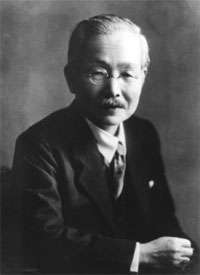Kikunae Ikeda
| Kikunae Ikeda | |
|---|---|
 | |
| Born |
Kikunae Ikeda 8 October 1864 Genji Era in Kyoto Japan |
| Died |
3 May 1936 (aged 71) Tokyo, Japan |
| Education | Science Faculty of the Tokyo Imperial University |
Kikunae Ikeda (池田 菊苗 Ikeda Kikunae, 8 October 1864 – 3 May 1936) was a Japanese chemist and Tokyo Imperial University professor of Chemistry who, in 1908, uncovered the chemical basis of a taste he named umami. It is one of the five basic tastes along with sweet, bitter, sour and salty.[1]
In 1907 at the Tokyo Imperial University in Japan, Professor Ikeda was eating dinner with his family when he suddenly stopped. That day the dashi broth in his soup was more delicious than normal; after stirring a few times he realized the difference was the umami flavor from the addition of kombu. He understood that kombu was the secret to that flavor, and from that day on he studied the chemical composition of kelp.[1]
By 1908, he had isolated brown crystals of glutamic acid (glutamate) which conveyed the characteristic flavor. The chemical monosodium glutamate (MSG) is the chemical basis for the umami flavor. He chose to call it Ajinomoto (味の素, "essence of flavor"). By 1909 he had developed a process for mass-producing MSG.[1] He was able to extract MSG from wheat and defatted soybean, and patented the process for its manufacture. With this method the global production of MSG increased rapidly.[2]
Professor Kikunae Ikeda also studied other foods to see if they contained umami, and confirmed that glutamate was responsible for part of the flavor of meat, seaweed and tomatoes. He believed that humans likely developed a taste for glutamate because it signaled the presence of proteins.[1]
References
- 1 2 3 4 Kean, Sam (Fall 2015). "The science of satisfaction". Distillations Magazine. 1 (3): 5. Retrieved 2 December 2015.
- ↑ "Kikunae Ikeda Sodium Glutamate". Japan Patent Office History of Industrial Property Rights. Retrieved 2 December 2015.